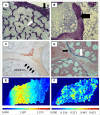The enigma of aluminum deposition in bone tissue from a patient with chronic kidney disease: a case report
- PMID: 29927461
- PMCID: PMC6533990
- DOI: 10.1590/2175-8239-JBN-3882
The enigma of aluminum deposition in bone tissue from a patient with chronic kidney disease: a case report
Abstract
About four decades ago, the relationship between dialysis-dementia and aluminum (Al) began to be established. The restriction of drugs containing Al and improvements on water quality used for dialysis resulted in the clinical disappearance of Al intoxication. However, high prevalence of Al deposition in bone tissue from Brazilian dialysis patients is still being detected. Through the case report of a patient on hemodialysis (HD) for one year, presenting significant Al deposition in bone tissue, we speculated if this problem is not being underestimated. We used extensive investigation to identify potential sources of Al exposure with a careful review of medication history and water quality controls. Al concentration was measured by different methods, including mass spectrometry, in poly-electrolyte concentrate solutions and solution for peritoneal dialysis, in an attempt to elucidate the possible sources of contamination. The objective of this case report is to alert the medical community about a potential high prevalence of Al deposition in bone tissue and to discuss the possible sources of contamination in patients with chronic kidney disease (CKD).
Cerca de quatro décadas atrás, a relação entre demência relacionada à diálise e alumínio (Al) começou a ser estabelecida. A restrição de medicamentos contendo Al e melhorias na qualidade da água utilizada na diálise resultaram no desaparecimento clínico da intoxicação por Al. Contudo, no Brasil continua a ser identificada uma elevada prevalência de deposição de Al no tecido ósseo de pacientes em diálise. O presente relato de caso de um paciente em hemodiálise (HD) há um ano com deposição significativa de Al no tecido ósseo nos leva a especular se esse problema não tem sido subestimado. Realizamos uma ampla investigação para identificar possíveis fontes de exposição ao Al, com uma revisão cuidadosa do histórico de medicação e dos controles de qualidade da água. A concentração de Al foi medida por diferentes métodos, incluindo espectrometria de massa, nos concentrados polieletrolíticos para hemodiálise e soluções de diálise peritoneal, na tentativa de elucidar as possíveis fontes de contaminação. O objetivo do presente relato de caso é alertar a comunidade médica sobre uma possível elevada prevalência de deposição de Al no tecido ósseo e discutir as possíveis fontes de contaminação nos pacientes com doença renal crônica (DRC).
Figures

Similar articles
-
Bone aluminum accumulation in the current era.J Bras Nefrol. 2024 Apr 29;46(3):e20240023. doi: 10.1590/2175-8239-JBN-2024-0023en. eCollection 2024. J Bras Nefrol. 2024. PMID: 38748946 Free PMC article.
-
Total allowable concentrations of monomeric inorganic aluminum and hydrated aluminum silicates in drinking water.Crit Rev Toxicol. 2012 May;42(5):358-442. doi: 10.3109/10408444.2012.674101. Crit Rev Toxicol. 2012. PMID: 22512666 Review.
-
Effect of CKD and dialysis modality on exposure to drugs cleared by nonrenal mechanisms.Am J Kidney Dis. 2015 Apr;65(4):574-82. doi: 10.1053/j.ajkd.2014.09.015. Epub 2014 Nov 21. Am J Kidney Dis. 2015. PMID: 25453994
-
Correlation of drug-related aluminum intake and dialysis treatment with deposition of argyrophilic aluminum-containing inclusions in CNS and in organ systems of patients with dialysis-associated encephalopathy.Clin Neuropathol. 1996 Nov-Dec;15(6):342-7. Clin Neuropathol. 1996. PMID: 8937781
-
[Aluminic intoxication in chronic hemodialysis. A diagnosis rarely evoked nowadays. Clinical case and review of the literature].Nephrol Ther. 2018 Feb;14(1):35-41. doi: 10.1016/j.nephro.2017.04.002. Epub 2017 Nov 23. Nephrol Ther. 2018. PMID: 29174672 Review. French.
Cited by
-
Renal osteodystrophy and clinical outcomes: data from the Brazilian Registry of Bone Biopsies - REBRABO.J Bras Nefrol. 2020 Jan 20;42(2):138-146. doi: 10.1590/2175-8239-JBN-2019-0045. J Bras Nefrol. 2020. PMID: 32756862 Free PMC article.
-
Bone aluminum accumulation in the current era.J Bras Nefrol. 2024 Apr 29;46(3):e20240023. doi: 10.1590/2175-8239-JBN-2024-0023en. eCollection 2024. J Bras Nefrol. 2024. PMID: 38748946 Free PMC article.
-
Effect of aluminum accumulation on bone and cardiovascular risk in the current era.PLoS One. 2023 Apr 20;18(4):e0284123. doi: 10.1371/journal.pone.0284123. eCollection 2023. PLoS One. 2023. PMID: 37079520 Free PMC article.
-
Aluminum Intoxication in Chronic Kidney Disease.J Bras Nefrol. 2021 Dec 3;43(4 Suppl 1):660-664. doi: 10.1590/2175-8239-JBN-2021-S110. eCollection 2021. J Bras Nefrol. 2021. PMID: 34910802 Free PMC article. No abstract available.
References
-
- Martin BR. Chemistry of Aluminum. In: De Broe M, Coburn JW, editors. Aluminum and renal failure. Dordrecht: Kluwer Academic Publishers; 1990. pp. 7–26.
-
- Dunea G. Dialysis dementia: an epidemic that came and went. ASAIO J. 2001;47:192–194. - PubMed
-
- Mahurkar SD, Salta R, Smith EC, Dhar SK, Meyers L, Jr, Dunea G. Dialysis dementia. Lancet. 1973;1:1412–1415. - PubMed
-
- Sandhu G, Djebali D, Bansal A, Chan G, Smith SD. Serum concentrations of aluminum in hemodialysis patients. Am J Kidney Dis. 2011;57:523–525. - PubMed
-
- Malluche HH. Aluminum and bone disease in chronic renal failure. Nephrol Dial Transplant. 2002;17:21–24. - PubMed
Publication types
MeSH terms
Substances
LinkOut - more resources
Full Text Sources
Other Literature Sources
Medical
Miscellaneous

